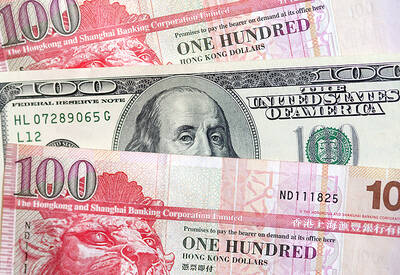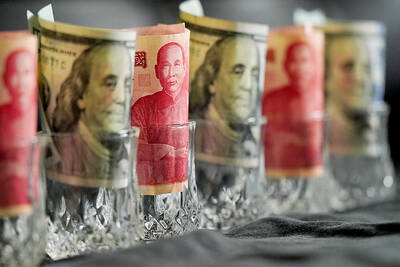Asia’s copper industry is to meet in Hong Kong starting on Tuesday to discuss a market that should be bursting with opportunities after China, the biggest consumer of the metal, called an end to the COVID-19 pandemic restrictions strangling its economy.
The government’s pledge to raise economic growth, and an increasingly outsized contribution to demand from its rapid build out of clean energy, have spurred optimism that China’s reopening would help offset weaker activity elsewhere in the world.
However, the reality on the ground is much gloomier as traders seek evidence of a uptick in consumption that has so far proved elusive in the months since Beijing lifted its “zero COVID” curbs.

Photo: Reuters
“Many people in the industry are disappointed by Chinese demand so far this year,” said Shen Haihua (沈海華), a portfolio manager at Hong Kong-based hedge fund Entropy Asset Management Ltd. “I think most specialists are on the short side.”
The London Metal Exchange’s (LME) gathering is its first in-person meeting in Asia since the pandemic struck, convening more than a thousand executives, traders, bankers and analysts to chew over the latest industry news, and wine and dine old friends in the territory’s bars and restaurants.
Less than two months ago, few were betting against copper’s prospects after the world’s top trader of the metal, Trafigura Group, told a conference in London that it expects prices to hit a record within a year.
What has changed is a slew of data indicating that China’s recovery is losing momentum. A survey of purchasing managers showed the factory sector contracting last month for the first time this year, while copper imports dropped to their lowest since October last year.
Chinese imports of the metal in the first four months are lagging 13 percent behind the pace set last year, when copper purchases boomed despite generally weaker demand for other commodities.
The metal is down about 8 percent on the LME so far this quarter. It on Friday fell 3.68 percent to US$8,163.50 per tonne.
In the US, copper for July delivery rose US$0.02 to US$3.73 per pound.
That speaks to one explanation for why consumption might have fallen short of expectations.
Chinese industry suffered less than other parts of the economy during COVID-19 slowdowns, said Capital Economics Ltd, a London-based research firm, which means that post-virus growth was only ever going to be modest.
At the same time, China’s need for metals like copper is being capped by softer demand for exports as other nations flirt with recession.
Copper prices have long been considered a useful barometer of an economy’s health because of its widespread usage, from power cables, to pots and pans and mobile phones. As such, its fortunes have been closely tied to China’s rapid growth in the past few decades, and a proxy to test the global demand.
Copper’s recent slump is telling us the global economy is in real trouble, Societe Generale SA strategist Albert Edwards wrote on Twitter.
So it is instructive that Chinese traders surveyed by Bloomberg ahead of the LME event are tilting toward prices falling in the short term.
Some said they are experiencing the worst margins in over 10 years, while smelters are turning to exports to compensate for a sluggish domestic market.
Copper is too scarce and too valuable to the energy transition to be on the ropes for long, but timing its resurgence is becoming increasingly fraught given the frailty of the world economy and the absence of robust Chinese demand.
From January to last month, copper in China has averaged about 400 yuan (US$57.90) per tonne less than London prices. The premium at the port of Yangshan, which measures import needs, has more than halved since mid-March and is bumping along near record lows, and that is during a second quarter which is usually considered to be a peak period of consumption among fabricators of the metal.
On the LME itself, the world’s premier exchange for metals, volatility — the lifeblood of the market — has slumped. On a 30-day basis, price fluctuations have fallen to their lowest since November 2020, forcing traders to the sidelines.
Lackluster consumption is the biggest problem, but another factor is that China’s smelting industry is still expanding. That means more demand for ores and concentrates mined overseas, and less for the refined metal that backstops futures markets such as the LME.
Copper’s value as an asset has also waned after the collapse of China’s biggest trader sent a chill through dealing rooms and subdued the appetite among lenders for using the metal as collateral on loans.
Other commodities:
‧ Gold for June delivery fell US$0.70 to US$2,019.80 per ounce, down 0.25 percent from a week earlier.
‧ Silver for July delivery fell US$0.27 to US$24.15 per ounce, down 6.86 percent from the previous week.
Additional reporting by AP

Hong Kong authorities ramped up sales of the local dollar as the greenback’s slide threatened the foreign-exchange peg. The Hong Kong Monetary Authority (HKMA) sold a record HK$60.5 billion (US$7.8 billion) of the city’s currency, according to an alert sent on its Bloomberg page yesterday in Asia, after it tested the upper end of its trading band. That added to the HK$56.1 billion of sales versus the greenback since Friday. The rapid intervention signals efforts from the city’s authorities to limit the local currency’s moves within its HK$7.75 to HK$7.85 per US dollar trading band. Heavy sales of the local dollar by

Taiwan Semiconductor Manufacturing Co’s (TSMC, 台積電) revenue jumped 48 percent last month, underscoring how electronics firms scrambled to acquire essential components before global tariffs took effect. The main chipmaker for Apple Inc and Nvidia Corp reported monthly sales of NT$349.6 billion (US$11.6 billion). That compares with the average analysts’ estimate for a 38 percent rise in second-quarter revenue. US President Donald Trump’s trade war is prompting economists to retool GDP forecasts worldwide, casting doubt over the outlook for everything from iPhone demand to computing and datacenter construction. However, TSMC — a barometer for global tech spending given its central role in the

The Financial Supervisory Commission (FSC) yesterday met with some of the nation’s largest insurance companies as a skyrocketing New Taiwan dollar piles pressure on their hundreds of billions of dollars in US bond investments. The commission has asked some life insurance firms, among the biggest Asian holders of US debt, to discuss how the rapidly strengthening NT dollar has impacted their operations, people familiar with the matter said. The meeting took place as the NT dollar jumped as much as 5 percent yesterday, its biggest intraday gain in more than three decades. The local currency surged as exporters rushed to

PRESSURE EXPECTED: The appreciation of the NT dollar reflected expectations that Washington would press Taiwan to boost its currency against the US dollar, dealers said Taiwan’s export-oriented semiconductor and auto part manufacturers are expecting their margins to be affected by large foreign exchange losses as the New Taiwan dollar continued to appreciate sharply against the US dollar yesterday. Among major semiconductor manufacturers, ASE Technology Holding Co (日月光), the world’s largest integrated circuit (IC) packaging and testing services provider, said that whenever the NT dollar rises NT$1 against the greenback, its gross margin is cut by about 1.5 percent. The NT dollar traded as strong as NT$29.59 per US dollar before trimming gains to close NT$0.919, or 2.96 percent, higher at NT$30.145 yesterday in Taipei trading